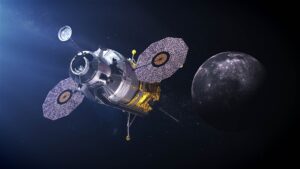The bill allocated $81.3 billion in funding for fiscal year 2022, including $25.04 billion for NASA.
The vote came after several hours of debate on amendments, most of which did not involve NASA. Members did swiftly approve on a voice vote one amendment, offered by Rep. Ben Cline (R-Va.), that requires $80 million of the $110 million included in the bill for nuclear thermal propulsion (NTP) research at NASA go toward work on a light demonstration.
At the CJS subcommittee markup July 12, Rep. Robert Aderholt (R-Ala.) had criticized the bill for not including that NTP flight demonstration language, which had appeared in past versions of the bill in recent years. “The omission imperils the progress of, and our previous investments in, nuclear thermal propulsion capabilities,” he said then.
The markup came a day after the committee released the report accompanying the bill, which provided more information on funding levels within NASA. The report originally specified $1.345 billion for the Human Landing System (HLS) program but expressed concern about NASA’s decision to select only one company, SpaceX, for an award in April. The committee “believes that continued agency investment beyond the HLS Option A Contract Award is vital to ensure continued competition among potential HLS providers,” the report stated, endorsing the latest effort as part of the Next Space Technologies for Exploration Partnerships (NextSTEP) program “to continue robust competition among potential providers for a future sustained HLS services capability.”
A manager’s amendment to the bill and report, passed by the committee on a voice vote, altered that language. While retaining the $1.345 billion for HLS, it stated the committee “elected not to further fence of condition funds for the Human Landing System at this time” because of the ongoing protests of the award being considered by the Government Accountability Office. The committee instead “urges NASA to bolster competition in lander development and production and improve the United States’ prospects for landing astronauts on the Moon in 2024.”
Aderholt had drafted an amendment that would have gone further on HLS. It would have directed NASA to select a second HLS company “as soon as practicable” with a minimum of $250 million in fiscal year 2022, and allowing that company to use a Space Launch System Block 1B rocket for its lander’s demonstration mission. The same amendment also backed development of a cargo version of SLS, at least one of which would launch no later than 2032.
Aderholt withdrew the amendment before the markup, but in brief comments about the manager’s amendment during the markup mentioned working with committee leadership on the revised HLS language.
Another provision of the report restores funding for NASA’s Stratospheric Observatory for Infrared Astronomy (SOFIA), an airborne observatory that the agency proposed shutting down in its budget request for the second consecutive year. The report provides $85.2 million, full funding, for SOFIA in 2022. “SOFIA can undertake astronomical observations not possible with other ground-based or space-based telescopes available today,” the report argued.
The report, while increasing funding for the SLS by nearly $150 million versus the administration’s request, does call on NASA to find ways to reduce the vehicle’s cost. It asks NASA to “engage an independent reviewer with aerospace production management experience to conduct a review of SLS completion costs” and “to determine how the cost of future flights of the SLS can be reduced.”
Although the bill cuts funding for NASA’s low Earth orbit commercialization efforts, citing a lack of “clear goals and metrics” for transitioning from the International Space Station, it does support a separate agency initiative to fly people on commercial suborbital vehicles. NASA’s Suborbital Crew program would get $10 million as part of the overall commercial crew effort, funding flights of non-NASA personnel on suborbital vehicles and directing NASA to “assess whether it should establish a relevant program office to qualify commercial U.S. suborbital vehicles and procure flights for NASA personnel.”



